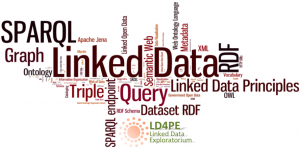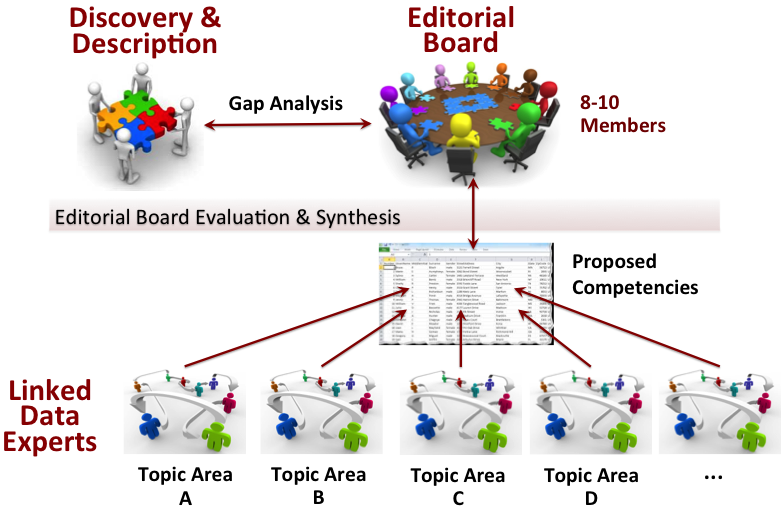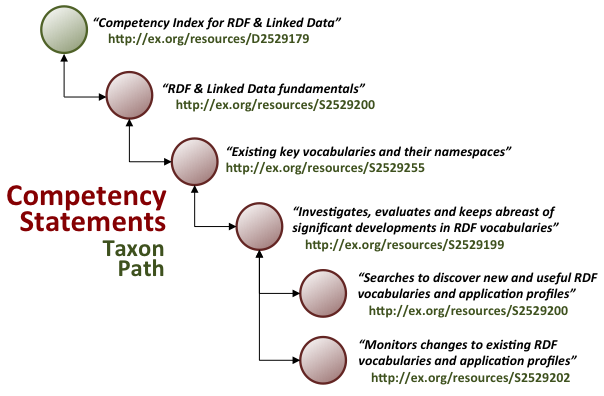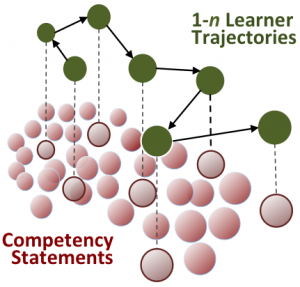LD4PE Overview—Briefing #4
- URL:
- https://ld4pe.dublincore.org/briefing-papers/ld4peoverview/
- Creator:
- Stuart A. Sutton (Information School, University of Washington)
- Last Update:
- 2015-08-01
Licensed under a Creative Commons Attribution 4.0 International License.
This Briefing Paper provides an overview of the IMLS-funded Linked Data for Professional Education (LD4PE) project to develop a competency-based prototype referatory of learning resources for teaching and learning Linked Data practices in design, implementation, and management.
1. Introduction
Understanding Linked Data standards and practices has become a key requirement for information professionals in galleries, libraries, archives and museums (GLAM). Major national libraries and bibliographic services are leading the trend to: (1) publish authority files, catalogs, datasets, and bibliographic standards as Linked Data; and (2) gather Linked Data from diverse external sources such as dbpedia, Freebase and MusicBrainz to enhance their local discovery and retrieval systems. Broad initiatives such as LODLAM and OpenGLAM are pushing the boundaries of Linked Data integration across galleries, libraries, archives and museums.
Professionals in cultural memory institutions find themselves on shaky ground as this seismic paradigm shift pushes the need for competent professionals from national centers toward local institutions. Indeed, the challenge to professional preparedness goes deeper, also affecting the teachers of the next generation of professionals and the trainers who provide continuing professional development.
This urgent need to develop Linked Data competencies in the professional workforce is driving major initiatives to provide learning resources (LR) about the underlying standards and data model—for example, the EU’s Euclid project, LOD2, School for Data, PlanetData, Open Data Institute, Lean Semantic Web, Cloudera, GATE, Linked Data Cookbook, and Cookbook for Translating Data Models to RDF Schemas. The products of these initiatives range from curricular structures and full courses to simple “recipes”—brief packages of “how-to” videos and step-by-step instructions targeted to specific (frequently unarticulated) learning outcomes. These scattered initiatives and their resources can be easy to find by those who already know what they are looking for, but everyone else struggles to put the available resources into a context.
The LD4PE project is developing the Exploring Linked Data website to help alleviate this struggle through support for the structured discovery of the LR available online through both open and commercial providers. At the heart of the website will be a competency framework for Linked Data practice that supports indexing learning resources according to the specific competencies they address. To accomplish this goal, Exploring Linked Data is leveraging Linked Data technology by modeling in RDF and assigning global identifiers (URIs) to statements of competence, and then using those URIs to map LR metadata to nodes in the Index. Deliverables of the LD4PE project include:
- Competency Framework. RDF-modeled “Competency Index for Linked Data” (Index) based on the ASN Description Language (ASN-DL) for describing formally promulgated competencies and benchmarks;
- Toolkit. An openly available, web-based tool set to support the: (a) generation of RDF metadata describing learning resources; and (b) creation of learner trajectory maps expressing curricular structures or personal learning journeys superimposed over the competency framework;
- Learning Resource Descriptions. A set of cataloged LR that have been mapped to the competencies and benchmarks of the Index to support competency-based resource discovery by teachers, trainers and learners.
- Explore Website. A website to be managed by DCMI as part of its educational agenda for open discovery of competency-based learning resources, access to the toolkit, learner maps, and supporting resources; and
- Best Practices. Readily accessible best practice documentation for all processes, from community-based competency framework development and LR description through learner trajectory creation.
2. Competency Index
Competency frameworks defining what a learner should know and be able to demonstrate underpin labor market credentialing mechanisms including college/university degrees, educational certificates, industrial certification, occupational licenses and even emerging micro-credentialing through digital badging. Learning environments strive for a tight coupling between these controlling frameworks, the resources necessary to achieve the learning objectives embodied in the frameworks, and what is actually assessed in terms of learner competence. [ 6 ]
2a. Index Development
Government and quasi-governmental agencies, commercial entities and professional organizations promulgate most of these competency frameworks under tight editorial control by a select body of experts. In contrast to these highly constrained contexts, the LD4PE is developing the means for crowd sourcing expertise in both the development and formative assessment of the project’s competency framework with synthesis and finalization of the published framework in the hands of a small, volunteer Editorial Board.
Projects such as schema.org are demonstrating that useful outcomes can be achieved through forms of crowd sourcing when technology enabled version control system—e.g., Github—help democratize the process of generation through broad community input.
Figure 1 illustrates the various components in the LD4PE competency-creation process. Discovery and Description, through its quest to discover, describe and map LR descriptions to competencies, provides a continuous environmental analysis of the evolving coverage of the Index in terms of:
- orphan competencies—competencies found in LR that cannot be mapped to the Index; and
- misaligned granularity—imprecise mapping options where there is a mismatch between granularity levels of Index competencies and those found in an LR.
Figure 1. Crowd sourcing expertise for the Index.
Linked Data Expert engagement through both solicited and unsolicited proposals for new competencies provides a mechanism through a version-controlled submission process for subsequent review and synthesis into the evolving Index by the Editorial Board.
The outcome of this process is a community-developed Index that describes a set of learning objectives and outcomes in terms of relevant knowledge, skills, practices, and habits of mind necessary to learn successful Linked Data practice from design and modeling through implementation and maintenance.
2b. Index modeling
The Index data is modeled as an RDF graph using the Achievements Standards Network Description Language (ASN-DL). The ASN-DL is comprised of two resource classes, the asn:StandardDocument representing the competency framework being described as a whole, and the asn:Statement representing the individual component competency assertions of the document. Object properties are used to replicate the original hierarchical or graph modeling of the canonical document while an evolving array of object properties express the semantic relationship between individual assertions.
The ASN-DL is extensible through addition of new properties and subproperty refinements to support domain specific profiles. Value vocabulary namespaces relevant to the jurisdiction of the competency framework may be specified and encoded as RDF using the W3C’s Simple Knowledge Organization System (SKOS).
Figure 2. Example Index ASN-DF modeling
The ASN-DL is extensible through addition of new properties and subproperty refinements to support domain specific profiles. Value vocabulary namespaces relevant to the jurisdiction of the competency framework may be specified and encoded as RDF using the W3C’s Simple Knowledge Organization System (SKOS). To date, LD4PE has not needed to define any project-specific value vocabularies.
2.c Index scope
One of the major challenges during the early months of the process has been operationalizing the term “Linked Data” in such a way that the scope of both the developing Index and the LR to be described and mapped are tractable within the context of the 2-year grant. “Linked Data” denotes a method for publishing structured data on the web that builds on: (1) a set of open standards and technologies to support semantic queries and graph traversal such as HTTP, URI/IRI, RDF, RDFa, SPARQL, triplestores, OWL, SKOS and others, and (2) the four practices first set out by Sir Tim Berners-Lee—use URIs as names for things; use HTTP URIs so that people can look up those names; When someone looks up a URI, provide useful information, using the standards (RDF, SPARQL); include links to other URIs so that they can discover more things. [ 1 ] While the scope of the Index and the LR descriptions to be included in Exploring Lined Data could extend across the full substrate of specific areas of competence supporting practice, such a broad scope is untenable in terms of a single competency framework. The project continues to struggle with this scoping issue.
3. Toolkit
The LD4PE project is committed to development using open standards, and, where appropriate, adaptions of existing tools and toolsets—implementing anew only where necessary. The LD4PE toolkit will be a set of open tools that enable Exploring Linked Data. Key areas of project implementation are light-weight, browser-based editors for creation of LR descriptions, competency descriptions and a mapping mechanism for creating learner trajectories.
3a. Metadata Generation Tools
To support the generation of metadata describing LR and for authoring the Index and its competency assertions, the project is developing an open toolkit of browser-based editors implemented using AngularJS for: (a) RDF LR descriptions based on an application profile of the LRMI (schema.org) schema, and (b) Index metadata based on the ASN Description Language (ASN-DL) for competency framework modeling and description.
3b. Learner Trajectories Tool
While the Index defines a set of competencies, it neither prescribes any competencies as “core” nor defines a logical sequencing of its components. In other words, the Index does not, in itself, define a curriculum by prescribing a single learning trajectory or pathway through the set of competencies expressed as nodes in the Index graph. The LD4PE project will customize existing tools to enable teachers, trainers, and learners to map their own pathways through the Index graph. These pathways can be saved as named graphs that traverse, or overlay, the competency nodes of the Index.
The named graphs for learning trajectories or pathways may be identified as formal curriculum structures or as personalized trajectories created by instructors or learners as evidence of progress. They may also function as suggested paths forward in the learning process or as guides to other instructors or learners in creating their own trajectories.
Figure 3. Learning trajectory maps.
Several decades of research has shown that such maps reveal the macrostructure of the body of information or knowledge within a field, making the context of that information or knowledge more apparent and useful to learners (O’Donnell et al., 2002; Hall & O’Donnell, 1996; Hall & O’Donnell, 2010). [ 3 ], [ 4 ] & [ 5 ] Similarly, learning trajectory overlays contextualize competencies and learning outcomes in a “larger picture” of learning expectations, outcomes, and personal learner progressions.
Thus, LD4PE stands in sharp contrast to other projects in not prescribing a single curricular point of view but in providing instead the means for instructors, trainers and learners to chart multiple, diverse pathways for learning—pathways defined as public or private, individual or collective, prescribed or exploratory. Each named graph provides a different roadmap for discovering and traversing lesson plans, how-to recipes, webinars, and tutorials that have been described and aligned to the competency nodes of the Index graph.
4. Architecture
The Exploring Linked Data technical architecture consists of a WordPress public interface on top of a triplestore managing LR descriptions and learning trajectories. The Index will be publicly available through the ASN-D2L open repository, and reflected through WordPress as a custom taxonomy.
Figure 4. Exploring Linked Data architecture.
The toolkit comprised of the editing and learner trajectory tools will function as open, stand-alone applications that can be used independent of the WordPress instance and the triplestore. While the initial goal is to serve as a referatory, some LD4PE project partners will be creating LR to be hosted by Exploring Linked Data. Video-based LR will be streamed from publicly accessible services such as YouTube, SlideShare and Vimeo.
The Exploring Linked Data website will primarily provide competency-based access to learning resources. In addition, it will provide a publication venue for both learning trajectory maps and select LR such as a pilot set being created by project partners Sungkyunkwan University Institute of Information and Management (Korea), OCLC, Elsevier, Synaptica, and Access Innovations. Developed and managed by the LD4PE Project, the website will mature to become part of the Dublin Core Metadata Initiative’s freely available toolset. WordPress out-of-the-box social media functions, including broadcast and recommender systems, will foster the engagement of domain experts, teachers and trainers, learners, and resource providers.
5. Best Practice Documentation
Publicly available guidelines will be published through the Exploring Linked Data website covering best practices in:
- Community development and management of competency frameworks;
- Creation of useful metadata descriptions of LR using the LRMI application profile;
- Alignment of LR to relevant competencies; and
- Creation of LR targeted to specific competencies.
6. Conclusion
While LD4PE will focus on skills, knowledge, and professional practice in the area of Linked Data, nothing precludes the extension of its competency-based approach to other areas of LIS, archives, and museum curricula. Similar competency frameworks could be developed describing practice in knowledge organization systems, cataloging, and organizational management.
This approach will be appropriate wherever the goal is for learners to achieve competence within a defined set of knowledge, skills, and habits of mind. DCMI is committed to sustaining the products and assets of this work moving forward because it sees the project’s conceptualization and its outcomes (including best practice documentation related to the framework itself) as generalizable to all areas of principled metadata design and best practice, while also providing a guiding template for future development of DCMI’s education and training agenda.
At the close of the IMLS-funded project in late 2016, management of Exploring Linked Data with fall to DCMI’s Education & Outreach Committee and a standing Task Group (currently called the LD4PE Task Group). Under this leadership, the content of Exploring Linked Data will extend beyond the prototype’s focus on Linked Data to other areas of professional competency-based education and training in metadata design, implementation, and use.
Acknowledgements
The work described in this poster is partially funded by the Institute of Museum and Library Services (IMLS).
References
[1] Berners-Lee, Tim (2006). Design Issues: Linked Data. Retrieved June 28, 2015 from http://www.w3.org/DesignIssues/LinkedData.html.
[2] Crandall, M.D., Tennis, J., Sutton, S.A., Baker, T. & Talley, D. (2013). Planning a platform for learning linked data. In Moen, W. & Rushing, A. (Eds.), International Conference on Dublin Core and Metadata Applications. Retrieved June 28, 2015 from http://dcpapers.dublincore.org/pubs/article/view/3693/1916.
[3] Hall, R.H. & O’Donnell, A. (1996). Cognitive and affective outcomes of learning from knowledge maps. Contemp. Educ. Psychol. 21, 94-101.
[4] Hall, R.H., Hall, M.A. & Saling, C.B. (2010). The Effects of graphical postorganization strategies on learning from knowledge maps. J. Exp. Educ. 67(2):101-112 (DOI:10.1080/00220979909598347).
[5] O’Donnell, A.M., Dansereau, D.F. & Hall, R.H. (2002). Knowledge maps as scaffolds for cognitive processing. Educ. Psychol. Review 14, 71-85.
[6] Sutton, S. A. & Golder, D. (2008). Achievement Standards Network (ASN): An application profile for mapping K-12 educational resources to achievement standards. In Heike Neuroth (Ed.), Proceedings of the International Conference on Dublin Core and Metadata Applications, (pp. 69-79). Retrieved, June 28, 2015 from http://dcpapers.dublincore.org/ojs/pubs/article/view/920/916.
[7] Ward, N. & Nicholas, N. (2010). Benefits of machine readable curricula. Retrieved, June 28, 2015 from http://bit.ly/CurriculaBenefits.





